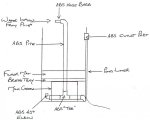JohnHuff
I know nothing.
- Joined
- Apr 17, 2012
- Messages
- 2,257
- Reaction score
- 1,621
- Location
- At my computer
- Hardiness Zone
- 1a
- Country

Somehow it makes more sense to have the small gravel at the bottom and the big rocks on top and have it a downflow filter. Then to clean, bubble the water from underneath. This way the debris won't pass openings which are smaller than them.
The way it is set up. The bigger rocks are at the bottom and small gravel at the top, and it's an upflow filter. But when he does the bubbling action, the big debris which is caught at the bottom will need to go through the medium and small sized openings to reach the exit at the top.
The way it is set up. The bigger rocks are at the bottom and small gravel at the top, and it's an upflow filter. But when he does the bubbling action, the big debris which is caught at the bottom will need to go through the medium and small sized openings to reach the exit at the top.






